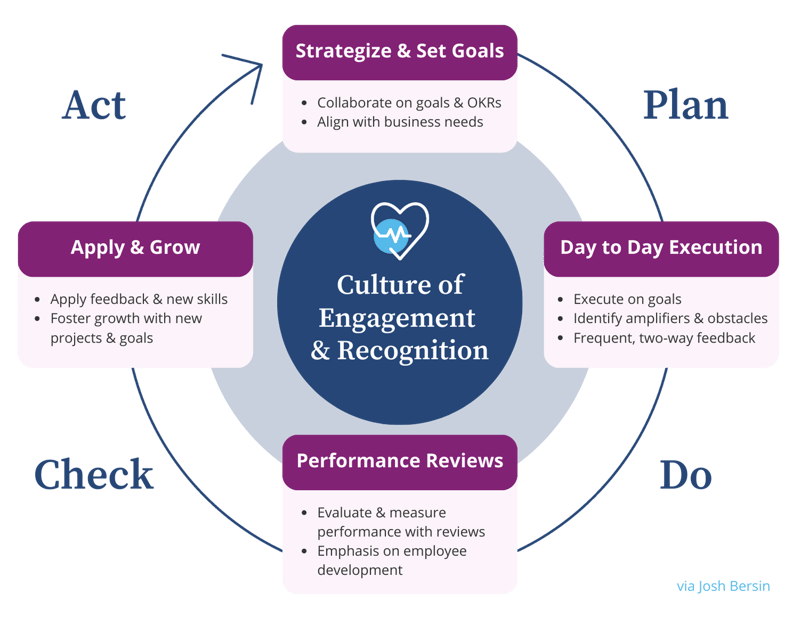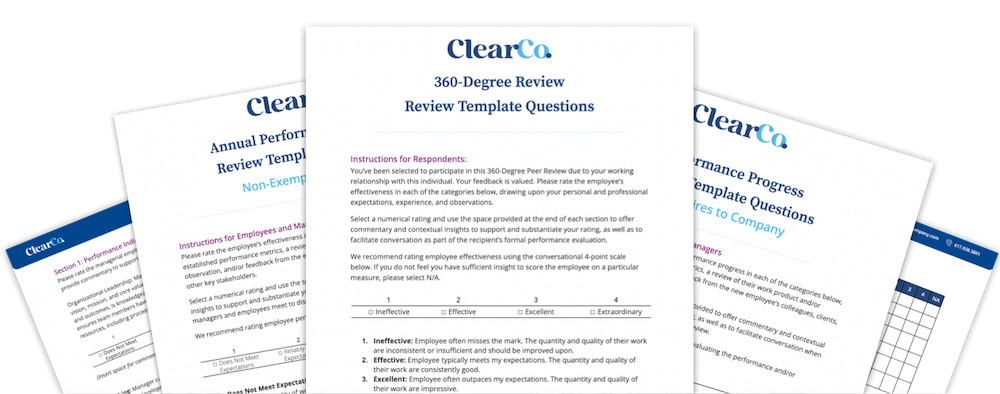This guide to the performance management process was first published in December 2023 and was updated in May 2025.
When we think of employee performance, our first thought is often the annual performance review. But great performance management requires so much more than one meeting each year — it’s an ongoing process. It doesn’t need to be a daunting one that’s feared by managers and employees alike.
The right performance management process can be a magic formula for business success. It can help your employees excel at work and gain new skills. Your process can increase engagement and boost retention. It can even build trust and foster closer relationships at work (which, research shows, is great for your people and your business).
Keep reading to learn more about effective performance management processes and how to create them.
What Is the Performance Management Process?
The performance management process is a collaborative, ongoing communication process in which employees and their managers work together to plan, monitor, and evaluate the employee’s work. It also helps ensure that employees’ goals align with organizational goals.
Key elements of the performance management process include coaching and feedback from managers, formal and informal performance reviews, goal setting and tracking, and rewards and recognition. With a process, these elements come together seamlessly to optimize employee performance and drive business outcomes.
Why You Need a Performance Management Process
A continuous performance management strategy involves a lot of moving parts: regular check-ins, performance appraisals, goal-setting and tracking, giving feedback, recognition, and rewards, and planning for the future. For complex, long-term strategies like performance management, establishing processes helps create a framework for success.
Processes help eliminate wasted effort and increase the consistency of what is produced, whether it’s a product, service, or outcome, like improving performance. A process of any kind sets a standard, helps ensure no important steps are missed, and makes it easier to train future employees.
The benefits of a performance management process are many, and there’s plenty of evidence to back them up. Here are just a few:
- Increases Employee Engagement: Research shows that 80% of employees who received useful feedback from their manager in the past week are highly engaged. If they get feedback daily, they’re nearly four times more likely to be motivated to do their best work. Performance management processes facilitate more opportunities for employees to get regular feedback and recognition, which are key elements of engagement.
- Drives Higher Productivity: More frequent recognition not only drives engagement but also motivates employees to work harder. Performance management processes also ensure that every person’s goals are aligned with the company’s highest priorities. Aligning goals maximizes the impact of the work each employee is doing and drives the business forward.
- Improves Employee Retention: It’s never a good time to lose your valuable employees, but that goes double during a skilled labor shortage. Boost retention by communicating more and supporting employee development, key aspects of effective performance management. When employees receive ongoing feedback and are supported in their career growth, retention can increase by as much as 34%.
- Enables Data-Informed Decision-Making: A regular, standardized performance evaluation process makes it possible to gain invaluable insights into employee performance, strengths, and areas for improvement. If you’re leveraging performance management software, you can gather this data effortlessly and then access useful reports that help you make sense of it. These insights help your HR team and company leaders make informed decisions related to promotions, compensation adjustments, and workforce planning. You’ll be able to make strategic decisions that align with your business objectives and maximize your employees’ talent.
The advantages of performance management also include the ability to spot and address issues quickly and create tailored employee development plans. A structured process helps increase fair performance ratings and rewards by ensuring reviews are consistent and objective, and paves the way for a positive feedback loop.
Your approach to employee development, communication, and recognition shapes your company culture and impacts everything from productivity to morale. That’s why a performance management process is vital to prime your organization for continued growth and success.
4 Steps to the Performance Management Process
Your specific performance management processes — e.g., the type and number of reviews given per year or employees’ preferred ways to receive recognition — depend on the industry you’re in and the roles you’re evaluating.
No matter the details, you can use the four steps of the performance management cycle as a guide for creating your process:
- Plan
- Do
- Check
- Act

Let’s take a closer look at these phases so you can create a performance management plan that works for your organization.
1. Plan: Strategize and Set Goals
The first step in an effective performance management process is the planning stage. The highest level of planning occurs when businesses set goals and departments determine the key performance indicators (KPIs) they need to achieve those goals. From there, managers and employees work together to set individual goals that align with the department's and company's objectives.
This is an important first step in performance management because it gives employees clear direction — a roadmap to what they need to accomplish. It also ensures they’re working on tasks that directly contribute to business goals and objectives.
2. Do: Execute Goals and Monitor Progress
Step two of the performance management process is when you find out if your goal-setting methods work. Monitoring progress closely as employees and teams work toward their goals increases your company’s agility. Whether someone is falling behind or crushing their quotas, tracking goals enables managers to provide coaching, adjust goals, or give a shout-out in real time.
Performance management technology offers a range of tools to make this step easier. Goal-setting tools simplify collaboration between managers and employees, as well as company-wide goal alignment. Your people can provide public or private goal updates and create a digital record of their accomplishments, too.
3. Check: Communicate Often
The third step in performance management processes is communication. At this stage, goals are set, employees are working to achieve them, and managers are keeping an eye on progress. Now, you need communication strategies so that employees are empowered to ask questions and get advice, and managers can ensure that goals aren’t too easy or unattainable and stay on track until they are completed.
Communicate more often and effectively about performance with these strategies:
- Weekly 1:1s: Engaged employees are more likely to have regular check-ins with their managers each week. This approach also gives managers the chance to improve their feedback skills and say “thank you” to their employees more often.
- 360-Degree Reviews: These reviews are completed by a handful of the employee’s colleagues and are commonly used in leadership reviews. They help create a more complete picture of performance for fair and thorough evaluations, and increase confidence in the review process.
- Constructive Feedback: Feedback needs to be useful and specific if you want to retain your people — 40% of employees who receive low-quality feedback are looking for a new job. On the other hand, with continuous feedback and performance discussions, most employees feel motivated and satisfied with their jobs and are unlikely to quit.
- Regular Recognition: Don’t underestimate the power of expressing appreciation. If employees received recognition more often, 53% would stay at their company longer, and 69% say they’d be motivated to work harder. You can start a recognition program at no cost by encouraging managers to acknowledge great work in weekly team meetings and during one-on-one meetings.
Employees want to understand how they’re doing — whether positive or negative, 85% want more feedback. Better communication has the potential to solve many common performance problems and has a positive ripple effect on peer relationships, company culture, and employee engagement.
4. Act: Make Informed Decisions
This step is the culmination of your performance management process. In step 3, you gained insights into employee performance, like which ones are high performers, their strengths and weaknesses, and how to best motivate them. In step 4, you use what you learned to make changes to your processes and decisions about your workforce.
Here are a few examples of how performance insights can inform human resources strategies:
- High performance ratings can reveal the most effective management styles.
- Performance review results can reveal areas of weakness where more training might be needed.
- Performance ratings support the need for performance improvement plans or eligibility for promotions, ensuring your organization employs engaged top talent.
- Performance reviews shed light on top performers, giving you the data you need to reward excellence with fair compensation and implement effective pay-for-performance strategies.
You can’t afford to lose top talent to problems you can solve, like a neglected or nonexistent performance management process. If you want to attract great candidates, enhance employee engagement, boost productivity, and achieve strategic goals, you need a well-structured process.
Unlock Your Team’s Potential With Effective Performance Management
Clear expectations, frequent, actionable feedback, and a culture of continuous improvement empower employees and motivate them to do their best at work. Enable every person to make meaningful contributions and reach their full potential in your organization with a strong performance management process supported by an excellent employee performance management system.
Strengthen the performance management framework at your organization and give engagement and productivity a boost with a mid-year check-in. Get our Mid-Year Performance Review bundle to get started.


.png)
